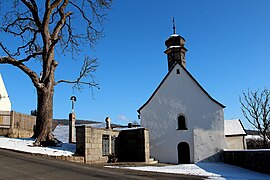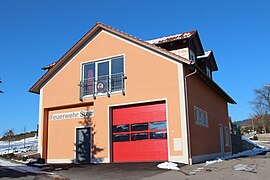Stone (pfreimd)
|
stone
City of Pfreimd
Coordinates: 49 ° 30 ′ 44 ″ N , 12 ° 13 ′ 28 ″ E
|
||
|---|---|---|
| Height : | 430 m above sea level NHN | |
| Incorporation : | January 1, 1972 | |
| Postal code : | 92536 | |
| Area code : | 09606 | |
|
Location of Stein in Bavaria |
||
|
Town View (2009)
|
||
Stein (also Stein an der Pfreimd , Stein unterm Berg , Stein am Berg ) is a village in the northwestern district of Schwandorf ( Upper Palatinate ). The village is located in the valley of the Pfreimd river , about four kilometers northeast of the town of Pfreimd on the state road 2157 from Pfreimd to Trausnitz .
history
The Lords of Stein
1118 the Lords of Stein can be documented with Udalricus de Steine . This sex can be documented on stone until the 16th century. The Veste Stein has probably belonged to the Leuchtenbergers since the 12th century, but was a separate fiefdom since the 14th century . On January 28, 1366 Ulrich II von Leuchtenberg was awarded half of the fortress stone in addition to other possessions . Ulrich's son Albrecht von Leuchtenberg sold the Veste Stein and the property belonging to it to the brothers Jorg and Peter Steiner on March 20, 1397. Weyglein Stainer zum Stayn is mentioned in the oldest Leuchtenberger fief book. He owned the Veste Stein and all that he has czum Stain, and a tenth over the yard czu Kneczendorf (neighboring town Gnötzendorf)…. The noble family of Steiner can be traced with Heinrich den Steiner in Schiltern. In 1408 Niklas Steiner and Hans Steiner had five farms in Lückenrieth near Leuchtenberg. Between 1417 and 1432 Mathes Steiner appeared again and again about the stone in the documents. On April 4, 1440, Landgrave Johann von Leuchtenberg decided in the inheritance process for the seat in Stein in favor of Dietrich Liechtenecker and Johann Kremnitzer from and to Stein Castle. Hilpolt and Heinrich Steiner's claims were rejected. But after Kremnitzer's death the Steiners were enfeoffed with stone again. “Wilhelm vom Stein zum Rackenstein, mentioned repeatedly between 1493 and 1510, saw himself after the death of his brother Hans and his wife Ursula, née. Pfreimder, forced to mortgage his seat in Stein ”. On February 20, 1497, Wilhelm vom Stein zu Rackenstein had sold all of the kilns and forest land in his possession to Georg Mendel, the hammer master of Diebrunn.
The Lords of Prandt
On February 11, 1524 Mathes vom Stein sold the Veste Stein and everything that belonged to it to Georg von Prandt. In 1528 Mathes vom Stein also parted with his goods in ponds, which the Prandts also acquired. The Prandt family had taken over Hohentreswitz in 1576 and had thus risen to become one of the most powerful Landsassen families in the Nabburg office. A list made in 1595, the so-called Turkish tax assessment, shows that “Stain am Berg” had 17 subjects who had to pay 13 guilders, 32 kreuzers and 3 pfennigs in taxes to finance the Turkish wars . In 1599 Veit Hans von Prandt died without a male heir. Inheritance disputes followed, Hohentreswitz and Weihern were sold by the Prandts.
The gentlemen from Singer
From 1621 on, Johann Singer on Stein was unequivocally established. In the turmoil of the Thirty Years' War from 1618 to 1648, which was a conflict for supremacy in the Holy Roman Empire of the German Nation and in Europe and at the same time a religious war, Stein was on the verge of ruin. The war had reached the Upper Palatinate in 1621, with devastating economic, social and cultural effects. The Nabburg office, to which the Hofmark Stein belonged, was badly affected. In 1632 the Singer heirs asked the government in Amberg for food and clothing.
Gobell, Schrenk and Kreuth
After the death of Hans Albrecht Singer, Stein came to Christian Gobell (also Gobelli, Kobelli). According to the loan certificate (= reverse letter) dated January 3, 1650, the castle and the Hofmark Stein were transferred to him. Christian Gobell died in 1657 and his son-in-law Georg Karl von Schrenk took over the estate. Max Christian von Schrenk, his widow Maria Elisabeth Freifrau von Schrenk, née Ginger, followed. 1740 is documented by Joseph August von Schrenk, who was followed by his widow Maria Francisca. Maria Francisca von Schrenk, married to Johann Baptist Freiherrn von Albersdorf for the second time, exchanged the Hofmark Stein, Glaubendorf and Gröbmühle with possessions of the Counts of Kreuth (also Kreith) on January 17, 1750. The Kreuther were already in the possession of the manors Guteneck , Weidenthal , Gleiritsch and Willhof , located in the Nabburg district .
Korb, Podewils, Buttler and Duprel
In 1755, Aloys Bonaventura Count von Kreuth and his wife Maria Franziska sold the property on Stein for 22,000 guilders to the government councilor and chairman of the Jews in Sulzbach, Joseph Ignati Corbinian von Korb and his wife Maria Catharina Francisca, née. from Haan. In 1762 Maria Anna Freifrau von Podewils bought the Stein estate for 23,500 guilders. Their daughter Maria Eleonora von Podewils inherited the property under guardianship. She married Count Theobald Wenzel von Buttler. Either 1802 or 1805, the information is not clear, Stein passed to Johann Baptist von Duprel.
Stein Castle then and now
The stone castle at the Pfreimd , including Schloss Stein called, is the ruins of a hilltop castle . The facility was built on a rock spur above the Pfreimd . There are several buildings within the castle walls, including the former castle; this is a two-storey, plastered gable roof structure , which essentially dates from the 16th century. The courtyard gate and the former gatehouse also belong to this listed complex. Most of the castle was demolished in the 18th century and a new building was built. Today's castle is built on the remains of a medieval keep . Parts of the castle wall made of quarry stone have also been preserved .
Attractions
- Remains of the medieval Stein Castle (privately owned)
- Castle Church of St. Matthew (18th century)
photos
Tax District and Parish Education
The Kingdom of Bavaria was divided into 15 districts in 1808. These districts were named after rivers based on the French model ( Naabkreis , Regenkreis , Unterdonaukreis , etc.). The districts were divided into district courts. The districts in turn should be divided into individual municipality areas. In 1811 the district court of Nabburg was divided into 58 tax districts. One of them was Stein, consisting of the villages Stein with the castle of the widowed Baroness von Duprel, Oberpfreimd, the hamlet Gnötzendorf, the manorial forest of Stein, called the Pfreimderschlag and the forest belonging to the Weihern estate, called Boden and Dobmaier Holz. The district had a total of 48 houses with 339 inhabitants. In the same year there were 22 chairmen in the district court of Nabburg, which corresponds to a municipality in today's sense. The chairmanship included Hohentreswitz, Söllitz, Stein, Gnötzendorf, Oberpfreimd, Weihern, Rappenberg, Löffelsberg, Aspachmühle, Stelzlmühle and the "City of Pfreimd with its directly ämtischen subjects". In 1819 there was a list of the existing communities in the Nabburg district court. One of them was the municipality of Stein, consisting of the village of Stein with 38 families and the hamlet of Gnötzendorf with 4 families. In 1828 there were 49 families with 208 people in Stein and four families with 23 people in the Gnötzendorf community. In the course of the municipal reorganization of Bavaria, Stein lost its status as an independent municipality and was incorporated into the city of Pfreimd on January 1, 1972, like the municipalities of Iffelsdorf and Weihern.
Individual evidence
- ↑ Elisabeth Müller-Luckner, Historical Atlas of Bavaria, part of Old Bavaria, Nabburg, p. 46
- ↑ Elisabeth Müller-Luckner, Historical Atlas of Bavaria, part of Old Bavaria, Nabburg, p. 233
- ^ Illuminatus Wagner, History of the Landgraves of Leuchtenberg, Volume 2, p. 261
- ↑ Elisabeth Müller-Luckner, Historical Atlas of Bavaria, part of Old Bavaria, Nabburg, p. 234
- ^ Elisabeth Müller-Luckner, Historical Atlas of Bavaria, part of Altbayern, Nabburg, p. 235
- ^ Elisabeth Müller-Luckner, Historical Atlas of Bavaria, part of Altbayern, Nabburg, p. 236
- ↑ State Archives Amberg, Amt Nabburg, No. 155
- ↑ Elisabeth Müller-Luckner, Historical Atlas of Bavaria, part of Altbayern, Nabburg, p. 239
- ↑ Alois Köppl, From the history of the community of Gleiritsch, p. 65
- ↑ State Archives Amberg, Landsassenurkunden, No. 202
- ↑ Elisabeth Müller-Luckner, Historical Atlas of Bavaria, part of Old Bavaria, Nabburg, p. 241
- ↑ List of monuments of Pfreimd .
- ^ Emmering, Ernst, The Government of the Upper Palatinate, History of a Bavarian Central Authority, Contributions to the History and Regional Studies of the Upper Palatinate, Issue 20, Regensburg 1981, p. 12 ff.
- ^ Elisabeth Müller-Luckner, Historical Atlas of Bavaria, part of Altbayern, issue 50, Nabburg, p. 402
- ^ Elisabeth Müller-Luckner, Historical Atlas of Bavaria, part of Old Bavaria, issue 50, Nabburg, p. 406
- ^ Wilhelm Volkert (ed.), Handbook of Bavarian Offices, Municipalities and Courts 1799–1980, p. 530
literature
- Elisabeth Müller-Luckner, Historical Atlas of Bavaria, part of Altbayern, Nabburg, issue 50, Munich 1981, ISBN 3-7696-9915-7 .
- Illuminatus Wagner, History of the Landgraves of Leuchtenberg, 6 volumes, Kallmünz 1940–1956.
- Wilhelm Volkert (Ed.), Handbook of Bavarian Offices, Municipalities and Courts 1799–1980, CH Beck'sche Verlagsbuchhandlung, Munich 1983, ISBN 3-406-09669-7 .
- State Archives Amberg, Amt Nabburg, No. 155.
- State Archive Amberg, Landsassenurkunden, No. 202.
- Alois Köppl, From the history of the community of Gleiritsch, 2nd edition, Gleiritsch 1988.
Web links
- Aerial photos of the place
- House book by Stein
- Stone on castle world
- Entry on Stein Castle in the private database "Alle Burgen".







